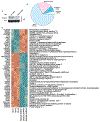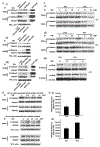Stat5 promotes metastatic behavior of human prostate cancer cells in vitro and in vivo
- PMID: 20233708
- PMCID: PMC6260789
- DOI: 10.1677/ERC-09-0328
Stat5 promotes metastatic behavior of human prostate cancer cells in vitro and in vivo
Abstract
There are no effective therapies for disseminated prostate cancer. Constitutive activation of Stat5 in prostate cancer is associated with cancer lesions of high histological grade. We have shown that Stat5 is activated in 61% of distant metastases of clinical prostate cancer. Active Stat5 increased metastases formation of prostate cancer cells in nude mice by 11-fold in an experimental metastases assay. Active Stat5 promoted migration and invasion of prostate cancer cells, and induced rearrangement of the microtubule network. Active Stat5 expression was associated with decreased cell surface E-cadherin levels, while heterotypic adhesion of prostate cancer cells to endothelial cells was stimulated by active Stat5. Activation of Stat5 and Stat5-induced binding of prostate cancer cells to endothelial cells were decreased by inhibition of Src but not of Jak2. Gene expression profiling indicated that 21% of Stat5-regulated genes in prostate cancer cells were related to metastases, while 7.9% were related to proliferation and 3.9% to apoptosis. The work presented here provides the first evidence of Stat5 involvement in the induction of metastatic behavior of human prostate cancer cells in vitro and in vivo. Stat5 may provide a therapeutic target protein for disseminated prostate cancer.
Conflict of interest statement
Declaration of interest
The authors declare that there is no conflict of interest that could be perceived as prejudicing the impartiality of the research reported.
Figures




Similar articles
-
Transcription factor signal transducer and activator of transcription 5 promotes growth of human prostate cancer cells in vivo.Clin Cancer Res. 2008 Mar 1;14(5):1317-24. doi: 10.1158/1078-0432.CCR-07-2024. Clin Cancer Res. 2008. PMID: 18316550
-
Autocrine prolactin promotes prostate cancer cell growth via Janus kinase-2-signal transducer and activator of transcription-5a/b signaling pathway.Endocrinology. 2007 Jul;148(7):3089-101. doi: 10.1210/en.2006-1761. Epub 2007 Apr 5. Endocrinology. 2007. PMID: 17412813
-
Pharmacologic inhibition of Jak2-Stat5 signaling By Jak2 inhibitor AZD1480 potently suppresses growth of both primary and castrate-resistant prostate cancer.Clin Cancer Res. 2013 Oct 15;19(20):5658-74. doi: 10.1158/1078-0432.CCR-13-0422. Epub 2013 Aug 13. Clin Cancer Res. 2013. PMID: 23942095 Free PMC article.
-
Jak2/Stat5 signaling in mammogenesis, breast cancer initiation and progression.J Mammary Gland Biol Neoplasia. 2008 Mar;13(1):93-103. doi: 10.1007/s10911-008-9062-z. Epub 2008 Jan 29. J Mammary Gland Biol Neoplasia. 2008. PMID: 18228120 Review.
-
Androgen receptor-dependent and -independent mechanisms driving prostate cancer progression: Opportunities for therapeutic targeting from multiple angles.Oncotarget. 2017 Jan 10;8(2):3724-3745. doi: 10.18632/oncotarget.12554. Oncotarget. 2017. PMID: 27741508 Free PMC article. Review.
Cited by
-
STAT5 confers lactogenic properties in breast tumorigenesis and restricts metastatic potential.Oncogene. 2022 Nov;41(48):5214-5222. doi: 10.1038/s41388-022-02500-w. Epub 2022 Oct 19. Oncogene. 2022. PMID: 36261627 Free PMC article.
-
Involvement of STAT5 in Oncogenesis.Biomedicines. 2020 Aug 28;8(9):316. doi: 10.3390/biomedicines8090316. Biomedicines. 2020. PMID: 32872372 Free PMC article. Review.
-
Cytokines, JAK-STAT Signaling and Radiation-Induced DNA Repair in Solid Tumors: Novel Opportunities for Radiation Therapy.Int J Biochem Cell Biol. 2020 Oct;127:105827. doi: 10.1016/j.biocel.2020.105827. Epub 2020 Aug 19. Int J Biochem Cell Biol. 2020. PMID: 32822847 Free PMC article. Review.
-
STAT5a/b Deficiency Delays, but does not Prevent, Prolactin-Driven Prostate Tumorigenesis in Mice.Cancers (Basel). 2019 Jul 2;11(7):929. doi: 10.3390/cancers11070929. Cancers (Basel). 2019. PMID: 31269779 Free PMC article.
-
Pharmacologic suppression of JAK1/2 by JAK1/2 inhibitor AZD1480 potently inhibits IL-6-induced experimental prostate cancer metastases formation.Mol Cancer Ther. 2014 May;13(5):1246-58. doi: 10.1158/1535-7163.MCT-13-0605. Epub 2014 Feb 27. Mol Cancer Ther. 2014. PMID: 24577942 Free PMC article.
References
-
- Ahonen TJ, Harkonen PL, Laine J, Rui H, Martikainen PM & Nevalainen MT 1999. Prolactin is a survival factor for androgen-deprived rat dorsal and lateral prostate epithelium in organ culture. Endocrinology 140 5412–5421. - PubMed
-
- Ahonen TJ, Harkonen PL, Rui H & Nevalainen MT 2002. PRL signal transduction in the epithelial compartment of rat prostate maintained as long-term organ cultures in vitro. Endocrinology 143 228–238. - PubMed
-
- Ahonen TJ, Xie J, LeBaron MJ, Zhu J, Nurmi M, Alanen K, Rui H & Nevalainen MT 2003. Inhibition of transcription factor Stat5 induces cell death of human prostate cancer cells. Journal of Biological Chemistry 278 27287–27292. - PubMed
-
- Ansieau S, Bastid J, Doreau A, Morel AP, Bouchet BP, Thomas C, Fauvet F, Puisieux I, Doglioni C, Piccinin S et al. 2008. Induction of EMT by twist proteins as a collateral effect of tumor-promoting inactivation of premature senescence. Cancer Cell 14 79–89. - PubMed
Publication types
MeSH terms
Substances
Grants and funding
LinkOut - more resources
Full Text Sources
Other Literature Sources
Medical
Molecular Biology Databases
Miscellaneous

